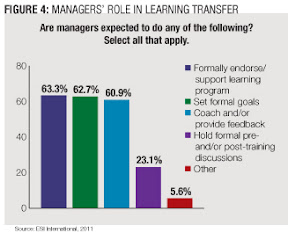In November 2010, Josh Bersin noted in his “Business of Talent” blog that the chief learning officer has a split personality and is actually three people in one: a chief culture officer, chief performance officer and chief change officer. But this leaves out one central role: the chief application officer.
While CLOs must ensure program offerings align with the business strategy and put an organization on a path toward change, none of this is attainable without a plan to make learning stick and improve performance, productivity and bottom-line results.
While there may not be someone with the title of chief application officer, a March learning transfer study conducted by ESI International, a learning consultant, shows there are best practices that can help ensure learning transfer occurs within the organization.
Learning Failure Points
Learning transfer has been scrutinized by myriad studies over the years, including ongoing research by the American Society for Training and Development. The implicit hope within these discussions is that sending employees to training will transfer into the workplace and result in both quantitative — cost savings — and qualitative — productivity, job satisfaction — outcomes.
While organizations may take the time to prepare employees for a learning engagement, budget for development and even measure learning impact, many continue to struggle to support and achieve true learning transfer.
The Transfer of Learning Survey, which was designed to assess an organization’s success or difficulty in fostering a learning transfer climate, identified this gap.
The survey was completed by more than 3,200 learning and development-related managers and leaders in government and commercial institutions spanning multiple industries around the globe. Findings indicated five areas where chief learning officers miss the mark when it comes to learning transfer (Figure 1):

1. Making the case for change: Why embark on this development intervention? What is the expected outcome?
2. Managing expectations and motivating the learner: Learners should understand that the organization expects them to apply what is learned and is prepared to reward their efforts.
3. Expecting manager support: Managers should offer learning support through discussion and reinforcement.
4. Making learning relevant: Provide better context by customizing offerings, including more modalities and making them application oriented.
5. Defining and measuring business impact: Learning can enhance individual and team performance and have a significant impact on an organization’s strategic and financial goals.
Take Learning Transfer Pulse
Before attempting to improve a learning transfer program, assess the current approach. ESI’s survey shows many organizations overestimate the success of their transfer climate.
For example, when asked if they have a formal process or system to ensure learning is applied successfully within their organization (Figure 2), one-third of survey respondents — 32.8 percent — say they do not have a formal process or system. This means 67.2 percent believe they do have a formal process. Two-thirds — 67.6 percent — estimate they apply more than 25 percent of training knowledge on the job.

Yet when asked what they used to prove or measure their learning transfer estimate (Figure 3), the aforementioned two-thirds who indicated they either have a formal learning transfer process or estimate more than 25 percent of knowledge is applied on the job can’t back that up. Almost 60 percent say the primary method for proving or measuring this estimate of learning transfer is either informal/anecdotal feedback or a guess. This calls into question their certitude about having a formal learning transfer system.

Make the Case for Change
Before directing people to attend any kind of learning intervention, explain why they need to, what they should expect and what the organization expects. This is often the most neglected area that connects a learning program to the business strategy.
CLOs should put a strategic focus on employee development, and this means change management needs to be implemented in the following ways:
• Articulate the as-is state and the “problem” at all levels within the organization.
• Communicate the vision and reasons why a change in knowledge/skills/competencies is needed to support the company’s growth/future strategy.
• Enact change management processes as part of skills development along with associated interventions, coaching and performance support systems.
To motivate learners to apply what they’ve learned, the majority of the Transfer of Learning study respondents — 75.1 percent — said they make sure training supports the organization’s goals, followed by 57.3 percent who make sure the trainee has the necessary time, tools and investment for learning application. Only 20 percent indicate there is any financial reward or incentive.
Further, when asked what specific rewards are used to motivate employees to apply what they learned, almost 60 percent listed the possibility of more responsibility, followed closely by an impact on the HR/performance review. Organizations may have to re-examine their strategies to motivate a new, changing workforce when it comes to learning transfer. If monetary rewards are out of the question, organizations should consider offering moments that instill pride and serve as an incentive for an employee, such as a lunch with the CEO.
Expect Manager Support
The survey uncovers a lack of manager involvement and commitment after learning — 70.9 percent of those surveyed said the organization expects managerial support as part of the learning process (Figure 4). Yet, when asked what managers are expected to do to ensure learning transfer, 63.3 percent said managers formally endorse the program, while only 23.1 percent hold more formal pre- and post-learning discussions.

Securing manager support is selected as the second-most important strategy to ensure learning sticks. However, to ensure a successful work environment where learning leads to on-the-job application, managers must do more than simply endorse a program. They must have clear responsibilities and provide tactical support every step of the way, including developing a plan for learning transfer, holding formal pre- and post-learning discussions and ensuring post-instruction reinforcement. CLOs can help foster this involvement by formalizing and tracking manager involvement in assessing impact, challenges and catalysts to implement what was learned.
Organizations and their employees are leveraging an ever-expanding array of tactics to recall information learned during programs, thereby increasing their use of just-in-time tools to apply knowledge and skills directly on the job. At the same time, there is a steady, continued reliance on traditional post-course reports, assignments, discussions and on-the-job aids, and more flexible, community-based support is emerging, such as communities of practice, peer coaching and social networks.
To make learning relevant, where possible learning and development professionals should involve employees in program design and follow-up application, provide refresher courses, just-in-time follow-ups and go-to mentors for post-event reinforcement, and align learning with efforts to solve failure points or current state challenges.
There are varying ways to determine learning value, and much of that is determined by whoever is asked to define it. CLOs assess learning value differently. However, executives will expect learning results in one or more of the following outcomes:
1. Maximizes returns: Improves business results, grows revenue, earnings and cash flow and reduces operations costs.
2. Increases agility: Enables the business organization and operations to adapt to changing business needs.
3. Minimizes risk: Ensures continuity of internal business operations while minimizing exposure to risk factors.
4. Improves performance: Improves business operations performance end-to-end across the enterprise and increases customer and employee satisfaction.
To ensure learning results in true business impact, employees should understand that the organization or sponsor expects them to apply what is learned, and that there will be a learning impact assessment by collecting data from them and other stakeholders, such as clients. It’s important to set expectations up front on how to measure. Then, CLOs should implement a scalable, repeatable and non-intrusive way to collect predicted outcomes and validate impact.
For some, it’s difficult to see a direct link between learning and business impact. In today’s economic climate, that puts learning budgets at risk. However, by analyzing the learning transfer climate, and then working to address the five common failure points for learning application, value can be shown through concrete results, and thinking will shift from ROI to VOI — the value of investment.
Whether helping drive learning application individually or working with others throughout the organization to help accomplish this mission, the chief learning officer can close key gaps and assume the role of chief application officer with or without a formal title.
Raed S. Haddad is senior vice president of global delivery services for ESI International, a learning consulting company. He can be reached at editor@CLOmedia.com.















